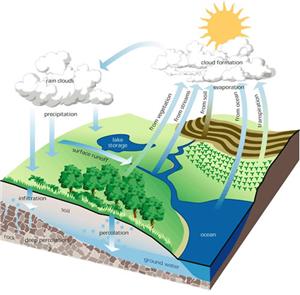The Hydrologic Cycle
The continuous movement of water on and below the earth's surface, and between the earth and the atmosphere, is known as the “hydrologic cycle”. Water exists in many forms as it circulates within the hydrologic cycle. Water present on the earth’s surface is called surface water. Water beneath the earth’s surface is called groundwater, while water vapour is called atmospheric water (WSC 2006).
Water from the atmosphere reaches the earth’s surface as precipitation in the form of rain, snow, hail, and sleet. After reaching the earth’s surface, water follows a combination of potential paths, including:
- Infiltratation into the soil, and potentially percolation through the soil to become groundwater;
- Storage as water in lakes, wetlands or oceans, or storage as snow or ice;
- Collection as surface water runoff moving downstream in a path through streams, rivers, lakes, and wetlands; or
- Evaporation from soil and water surfaces, or evaporation and transpiration from vegetation (evapotranspiration), to become atmospheric water. Water in the atmosphere is available to form precipitation as it cools and condenses, thereby completing the hydrologic cycle.









